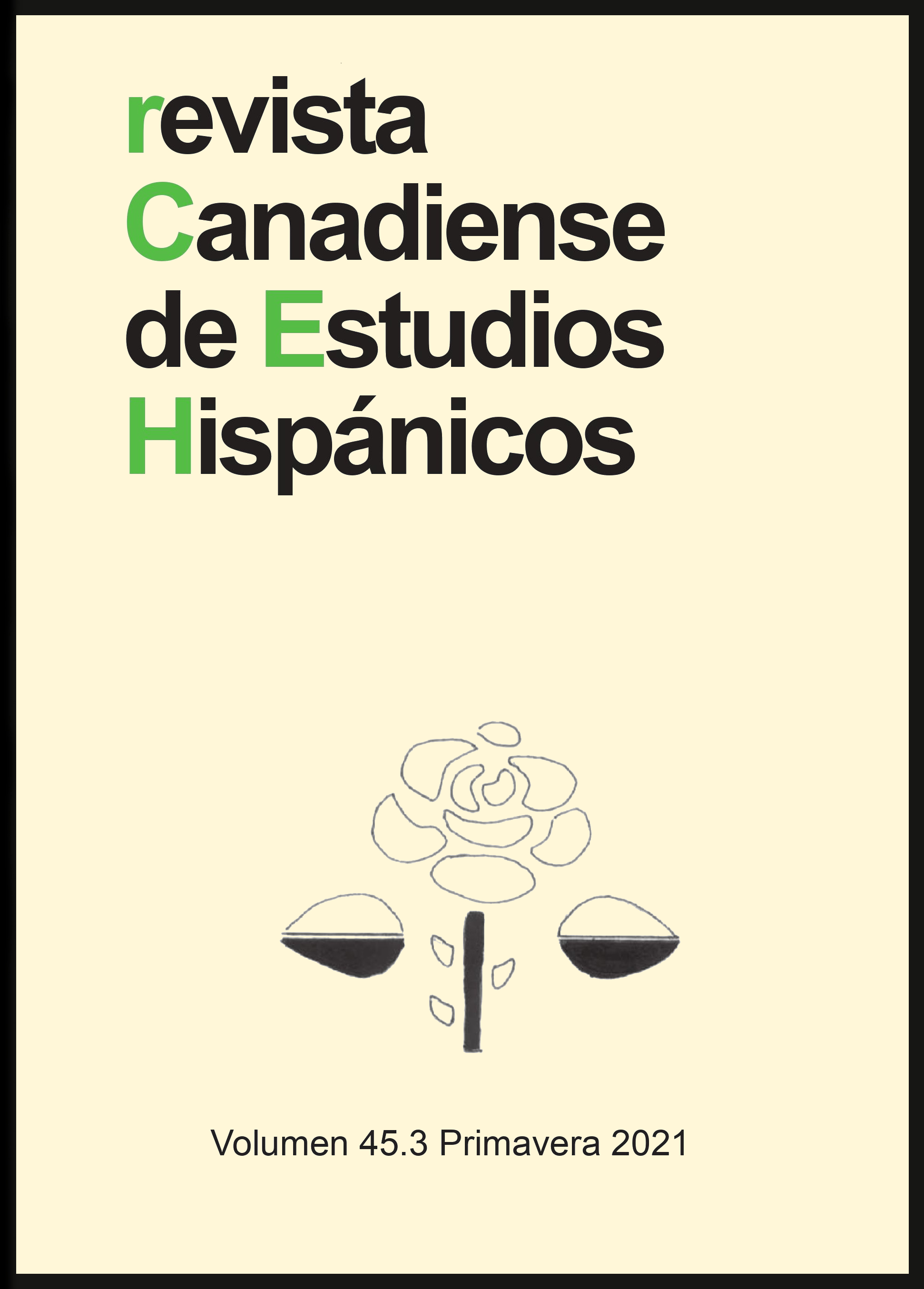Affect and Emotions in Two Chilean Postmemory Narratives: La dimensión desconocida by Nona Fernández and La resta by Alia Trabucco Zerán
DOI :
https://doi.org/10.18192/rceh.v45i3.6817Mots-clés :
affect, emotions, history, allegory, dictatorshipRésumé
La dimensión desconocida (2016) by Nona Fernández and La resta (2014) by Alia Trabucco Zerán are recent novels about the memory of the Augusto Pinochet dictatorship (1973-1990) in Chile that use emotions to reconstruct a historical era through memory. The two novels share an emphasis on the affect and emotions of both readers and characters. While La dimensión desconocida is a historical novel that invites the reader to identify and empathize with the protagonists, La resta is an allegorical novel that provokes the reader to think about history by startling him or her through the narration of the protagonists' violent games.
Références
ARECO, MAGDALENA, MARCIAL HUNEEUS, JORGE MANZI, AND CATALINA OLEA. Cartografías de la novela chilena reciente: Realismos, experimentalismos, hibridaciones y subgéneros (ensayos). Santiago: Ceibo Ediciones, 2015.
ALZATE, SERGIO. “El pasado es una hoja de ruta para el futuro.” Eltiempo.com. El Tiempo. 13 May 2018. N. pag. Web.
CABALLERO VÁZQUEZ, MIGUEL. “Museo de la Memoria y los Derechos Humanos de Santiago de Chile: crisis de memoriales y lógicas urbanísticas de mercado.” Revista Canadiense de Estudios Hispánicos 40.3 (2016): 509-33.
CHOSSUDOVSKY, MICHEL. “Chile September 11, 1973: The Ingredients of a Military Coup. The Imposition of a Neoliberal Agenda.” Globarlresearch.ca. Global Research. 11 Sep 2003. N. pag. Web.
COLLYER, JAIME. “Narrativa que resurge de las cenizas.” Inti: Revista de Literatura Hispánica 69-70 (2009): 99-114.
DION, LISA. Aggression in Play Therapy: A Neurobiological Approach for Integrating Intensity. New York: W.W. Norton & Company, 2018.
FERNÁNDEZ, NONA. La dimensión desconocida. Santiago: Penguin Random House, 2017.
“The Four of Us are Dying.” The Twilight Zone. Episode 13. Season One. CBS. January 1, 1960.
FRANKEN OSORIO, MARÍA ANGÉLICA. “Memorias e imaginarios de formación de los hijos en la narrativa chilena reciente.” Revista Chilena de Literatura 96 (2017): 187-208.
FLETCHER, ANGUS. Allegory: The Theory of a Symbolic Mode. Princeton: Princeton UP, 2012.
GARCÍA-CORALES, GUILLERMO. El debate cultural y la literatura chilena actual: un diálogo con cinco generaciones de escritores. Lewiston, NY: Edwin Mellen Press, 2007.
GERNSBACHER, MORTON ANN. “Activating Knowledge of Characters’ Emotional States.” Discourse Comprehension: Essays in Honor of Walter Kintsch. Eds. Charles A. Weaver, Suzanne Mannes, and Charles R. Fletcher. Hillside, NJ: Eribaum, 1995.
HIRSCH, MARIANNE. The Generation of Postmemory: Writing and Visual Culture After the Holocaust. New York: Columbia UP, 2012.
JAÉN, ISABEL. “Fascism, Torture, and Affect in Postwar Spain: Memoria Histórica Narratives and Audience Empathy.” The Palgrave Handbook of Affect Studies and Textual Criticism. Eds. Donald R. Wehrs and Thomas Blake. New York: Palgrave/Macmillan, 2017. 803-26.
JUKES, JACQUELINE A., AND JEFFREY H. GOLDSTEIN. “Preference for Aggressive Toys.” International Play Journal 1 (1993): 81-91.
LAZZARA, MICHAEL. Chile in Transition: The Poetics and Politics of Memory. Gainesville: UP of Florida, 2006.
“Nightmare at 20,000 Feet.” The Twilight Zone. Episode 123. Season Five. CBS. October 11, 1963.
PALMER BONTE, ELEANOR, AND MARY MUSGROVE. “Influences of War as Evidenced in Children’s Play.” Child Development 14.4 (1943): 179-200.
PARRA, NICANOR. “Noticiero 1957.” Antipoemas: Antología (1944-1969). Ed. José Miguel Ibáñez-Langlois. Barcelona: Seix Barral, 1981. 164-67.
“Periodismo de oposición: 1979-1989.” Memoria Chilena. N.d. N. pag. Web.
“Probe 7, Over and Out.” The Twilight Zone. Episode 129. Season Five. CBS. November 29, 1963.
RICHARD, NELLY. Cultural Residues. Trans. Alan West-Durán and Theodore Quester. Minneapolis: U of Minnesota P, 2004.
ROJO, GRÍNOR. Las novelas de la dictadura y la postdictadura chilena: ¿Qué y cómo leer? Vol. I. Santiago: LOM ediciones, 2016.
ROMERO, IVANA. “Nona Fernández: Cuando escribo, soy.” Eternacadencia.com. Blog. 1 March 2018. N. pag. Web.
ROTHLISBERGER, SILVIA. “Author Interview: The Remainder by Alia Trabucco Zerán.” Literarysouth.org. Literary South. 25 March 2019. N. pag. Web.
ROS, ANA. The Post-Dictatorship Generation in Argentina, Chile, and Uruguay: Collective Memory and Cultural Production. New York: Palgrave/Macmillan, 2012.
SKLAR, HOWARD. “Empathy’s Neglected Cousin: How Narratives Shape Our Sympathy.” The Palgrave Handbook of Affect Studies and Textual Criticism. Eds. Donald R. Wehrs and Thomas Blake. New York: Palgrave/Macmillan, 2017. 451-80.
“The Sixteen Millimeter Shrine.” The Twilight Zone. Episode 4. Season One. CBS. October 23, 1959.
TOMKINS, SILVAN. Affect Imagery Consciousness: The Negative Affects. Anger and Fear. Vol. III. New York: Springer Publishing Company, 1991.
TRABUCCO ZERÁN, ALIA. La resta. Madrid: Editorial Demipage, 2014.
VAN ALPHEN, ERNST. “Affective Operations of Art and Literature.” RES: Anthropology and Aesthetics 53-54 (2008): 20-30.
WELDT-BASSON, HELENE C. “Mario Vargas Llosa’s La fiesta del chivo: History, Fiction, or Social Psychology? Hispanófila 156 (2009): 113-31.
“Yo torturé.” Cauce. Semana del 23 al 29 de julio de 1985. Accessed June 15, 2019. Web.
Téléchargements
Publié-e
Numéro
Rubrique
Licence
© Helene C. Weldt-Basson 2023

Cette œuvre est sous licence Creative Commons Attribution 4.0 International.
Aquellos/as autores/as que deseen publicar en la RCEH o tengan publicaciones en esta revista aceptan los siguientes términos:
- La RCEH solo publica artículos inéditos.
- Los artículos enviados a la RCEH no deben estar bajo consideración en ninguna otra revista o editorial.
- Los/as autores/as podrán incluir imágenes cuando las consideren esenciales para su estudio. Es responsabilidad suya el obtener por escrito la autorización para su reproducción y presentarla a la RCEH.
- Los/as autores/as conservarán sus derechos de autor y garantizarán a la RCEH el derecho de primera publicación de su obra, el cuál estará simultáneamente sujeto a la Licencia de reconocimiento de Creative Commons que permite a terceros compartir la obra siempre que se indique su autor y su primera publicación en la RCEH.
- 12 meses después de la publicación de su obra en la RCEH, los/as autores/as podrán adoptar otros acuerdos de licencia no exclusiva de distribución de la versión de la obra publicada (p. ej.: depositarla en un archivo telemático institucional o publicarla en un volumen monográfico) siempre que se indique la publicación inicial en esta revista.


